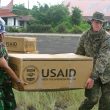Radio-to-radio needed
The real need for a public safety officer when responding to any of these situations is to carry a radio on the belt that offers the ability to reach whomever she or he needs to communicate with in real time. That need must be supported radio-to-radio without the use of infrastructure for on-scene use at many incidents.
Enter Software Defined Radio. As already demonstrated by companies such as Thales and Vanu, SDR offers the potential of providing a multi-band platform that supports a number of different public safety waveforms. A waveform is the “software package” that defines the air interface and protocols necessary to enable communications using a particular technology. Project 25 Phase I, M/A-COM EDACS and Motorola SmartNet are all examples of waveforms that could be supported on an SDR platform. Equipping a field officer with a radio that supported the waveforms of agencies in that geographic area, along with a common national interoperability waveform, would enable that officer to have direct interoperability without the need for enabling infrastructure.
Additionally, SDR offers important other benefits to public safety. The ability to download software onto an existing platform allows for the addition of new features to existing waveforms and supports forward migration to new technologies with new waveforms.
On-the-street reality?
However, SDR is not yet an on-the-street reality. Through a contract with DoD, Thales has developed its MBITR portable radio that is not yet type-certified for public safety use. Likewise, Vanu Inc has demonstrated a multi-mode multi-band radio operating on a Compaq iPAQ platform. This latter product is a proof-of-concept device, requiring repackaging into a ruggedized public safety housing, with the proper form factor and supporting characteristics. Both require added waveforms to be of significant benefit to the user community, though they have proven the SDR concept is viable. Vanu is also developing a proof-of-concept base station for use in rural areas where a single SDR processor will support waveforms for public safety as well as for commercial cellular voice and for commercial wireless data.
That is not to say that significant technological hurdles have been overcome. The development of a public safety portable subscriber set is hindered by a number of technology requirements: battery capacity, antenna development and physical form factor remain major issues, as does the cost of the overall product. SDR processors and broadband power amplifiers require significant power. Public safety users require a battery that will support a radio for shifts that routinely extend to 12 hours. Today's multiband antennas are physically too large to carry if they have to support a very wide range of frequency bands. And all of the hardware, including an appropriate battery must fit in an easy-to-carry package with an appropriate form factor that supports ease of use. Finally, the product must be affordable; while agencies will be willing to pay a premium for the features provided, all are constrained by today's limited public budgets.
But perhaps the greatest impediment to fielding a useful SDR product will be the licensing of intellectual property (patents). Each of the major public safety waveforms, with the exception of analog FM and Project 25 digital, will require negotiations with those manufacturers that could introduce major delays.
SDR will make its way into the public safety radio services. As with any new technology, introduction will be slow and the initial products costly. But the benefits obtained from the technology will eventually drive demand up and cost down. Will SDR be the ultimate solution to the interoperability problem? Only time will tell, but research to date certainly supports that claim, and significant R&D funds from both private and public sources are being devoted to the development effort.
John S. Powell is an electrical engineer and a director of the Software Defined Radio Forum, representing government agencies. Among his many achievements, Powell served as statewide Police Communications Coordinator for the University of California system. He is a life-member and past-president of the Association of Public Safety Communications Officials-International (APCO). He is a member of the Project 25 Steering Committee and has been a member of the California Legislature's Joint Committee on Fire, Police, Emergency and Disaster Services, APCO Law Enforcement Service Committee. Powell is past-chairman of the Interoperability Subcommittee of the National Coordination Committee, a federally chartered advisory committee to the FCC regarding implementing the 700 MHz public safety band and past-chairman of the FCC-chartered State Interoperability Executive Committee for the State of California, Governor's Office of Emergency Services. Recently, Powell has been consulting for several agencies within the U.S. Justice Department, the Department of Homeland Security, and the Executive Office of the President of the United States on issues related to public-safety communications interoperability, development of next-generation public safety broadband equipment and standards, and Software Defined Radio.
Interoperability:
-
The ability to talk to who you need to talk to when you need to talk (data and voice, realtime).
-
NOT the ability to talk with everyone all of the time!










